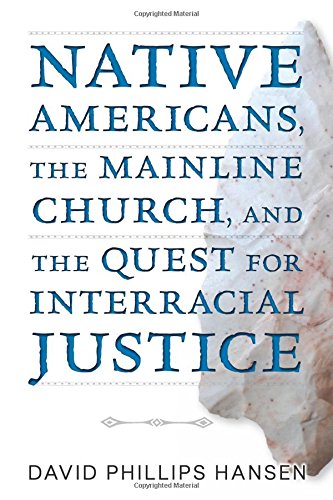
A Review of Native Americans, the Mainline Church, and the Quest for Interracial Justice
A rectangular pit lined with dressed stones stands on a low hill in Toadlena, New Mexico, near the center of the Navajo Nation. The pit comprises the basement and foundation of what had, years earlier, been my missionary family’s home. The pit is half-filled with charred timbers, a bathtub, a sink, and the rusted remains of a coal furnace. Sometime after my family moved away, the house burned to the ground. Investigators said the fire was started intentionally. It wasn’t the first time. Two other houses we had lived in had fallen to arson, never while my family lived in them, but when missionaries who followed my father did. I have always wondered if these events were pained attempts to redress wrongs—cultural genocide aided and abetted by missionaries’ actions in a land that did not belong to us.
It was from this context and its many implications that, as I read David Phillips Hansen’s Native Americans, the Mainline Church, and the Quest for Interracial Justice, I flagged lines and paragraphs in the book until its text block looked like a hedgehog. Hansen names his purpose as twofold: to deconstruct the church’s war on indigenous peoples in the US, and to set forth a pathway of theological, political, and economic reform that might result in a multicultural future. In his estimation, the book represents more of a synthesis of groundwork laid by other writers than it does original thought. Using this method, he has created a well-researched, clearly written, succinct and nuanced handbook that churches and other institutions can use for reparative work that Hansen describes as urgent. His sense of urgency comes in part out of lived experience in pastorates in Saskatchewan, Kansas and Hawai’i.
Having grown up as a guest in the Navajo Nation, a Missionary Kid, I share Hansen’s sense of urgency and obligation.
Having grown up as a guest in the Navajo Nation, a Missionary Kid, I share Hansen’s sense of urgency and obligation. When we talk about addressing genocide by murder, as well as genocide by ideology and psychology, we commonly speak of reconciliation. But Pastor Norman Blue Coat (Cheyenne River Sioux) and others have said that there can only be conciliation because reconciliation implies that there was once harmony, and such harmony has never existed among colonizers and colonized in the US. I have attempted some measure of conciliation on my own, but I was hungry to learn more about how the church, an institution of which I’m a member, can and must effect conciliation. Hansen’s book did not disappoint.
Rev. Hansen organized his text on Eric K. Yamamoto’s fourfold framework as explicated in the book Interracial Justice: Conflict and Reconciliation in Post-Civil Rights America. The process begins with recognition of the Church’s history of harm done to Native peoples. Recognition necessarily requires us to know the history of the church’s collusion with, and sometimes initiation of, the horrors of colonization. The author supplies a wealth of information, beginning with the many official church documents—the Doctrine of Discovery is probably most well known—that still inform institutional behavior today, contrary to what some believe. Hansen ably shows how the church worked hand in glove in the colonization process, supporting and benefiting from land grabs and the destruction of millions of Native lives. He shows in painful detail how the church was part of an ideological war—Christianizing people who had their own religious beliefs and practices, especially through boarding schools.
The second phase in seeking interracial justice requires that the church accept responsibility for its part in the oppression and exploitation of Native peoples that continues to this day. It means moving beyond apology to making the church accountable by freeing “ourselves from … assumptions of entitlement, superiority, and white privilege to create a new narrative fit for the future.”
In the third and fourth steps of enacting justice, Hansen shows how a changed narrative must result in revolutionary action on the part of the church. Reconstruction is reaching out in constructive ways to heal the wounds. Hansen quotes Kwok Pui-lan, “‘Postcolonial imagination’ refers to a desire, a determination, and a process of disengagement from the whole colonial syndrome.” This reimagining can include dialogs among equals in which there is no assumption that Christian beliefs and practices are in any way superior to Native beliefs and practices.
The fourth phase of questing for interracial justice is the most costly; it is here that Hansen refers to the cost of discipleship. The church must be willing to follow the way of the cross and lose its life to find it. Reparation, the act of repairing what has gone wrong, “requires the transfer of hard assets—land and money—and political power to indigenous communities.” The author supplies examples, such as returning hundreds of acres of land usurped for mission activities, and the United Methodist Church’s donation of $50,000 for a center for the education of the public about the Sand Creek Massacre on the site of the massacre. This is also where, if the church is to continue to include Native American Christians, it must change the US church’s narrative from the Exodus story of the conquest of Canaan to the Ezekiel narrative of living in harmony with people who already dwell in the land.
…the act of repairing what has gone wrong “requires the transfer of hard assets—land and money—and political power to indigenous communities.”
The land embodies one of the greatest differences between Native and non-Native peoples. As the late Elden Lawrence (Dakota) wrote, “…the Native believes he belongs to the land,…the White man believes the land belongs to him.” For Native people the land is sacred, and beliefs and practices are tied to the land. This is why the return of land is such a critical part of reparation. Throughout the book, standing in deep solidarity with Native people is a core concept and must be “based on a careful analysis of real life situations and finding in them common cause. Ethnic and cultural differences are respected. But rather than serving as a reason for division and noncooperation, the differences enhance our ability to work together to create alternative solutions to the situations in which we find ourselves—alternatives that benefit everyone.” One way for deep solidarity to be enacted is for the church to stand with Native people when they make claims for the return of lands and protection of sacred lands in court.
One area of need for justice that is not addressed in the book is the unique situation of urban indigenous people. These are often some of the most oppressed and alienated people in our society. Hansen rightly states that reparation is not about charity, although that is important. Rather, it is about ending oppression and exploitation, about relinquishing power and privilege. The congregation to which I belong extends a great deal of charity to urban Natives who join us for services. These are people living on the margins, and following services the church serves them hot meals and provides them with sack lunches as well as other basic needs for the week. I am prompted by the book to wonder how we might extend reconstruction and reparation in this local context as well as within the denomination.
There are school districts in the US that teach that Natives are people of the past, that they are no longer part of our world. Many books and articles that address inequities among disenfranchised groups mention most every group but one: Native Americans. Indigenous people are often rendered invisible within the quest for interracial justice. Native Americans, the Mainline Church, and the Quest for Interracial Justice is a book that offers churches a road to conciliation, provided they have ears to hear and are willing to pay the cost of discipleship. Hansen has shown how every mainline church owes a debt to indigenous people in the US.
Evangelical churches, too, owe a debt; however, the emphasis in evangelicalism on individual salvation can make it more difficult for those bodies to recognize the existence of institutional responsibility. Hansen and others have pointed out that in general, evangelicals are opposed to individual racism but have a difficult time, because of that orientation, recognizing institutional racism and the need to take responsibility for reconstruction and reparation. This book can be a guidebook for changing that.
Anna Redsand is the author of To Drink from the Silver Cup: From Faith Through Exile and Beyond. Her essays have appeared in several literary journals, and “Naturalization” was a notable in Best American Essays 2014. Her biography Viktor Frankl: A Life Worth Living won four national and international awards. She lives in Albuquerque, New Mexico, USA.

